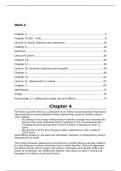Summary
Samenvatting exam 2 - adolescent development
- Course
- Institution
- Book
This summary contains the following literature: - chapter 4 - chapter 5 - chapter 6 - chapter 7 - chapter 9 (236-243) - chapter 10 - chapter 11 - chapter 12 - Cingel (2020) - Kaufman (2017) - Valkenburg (2017) & lecture notes (8 to 12)! In short, everything you need to learn for...
[Show more]



